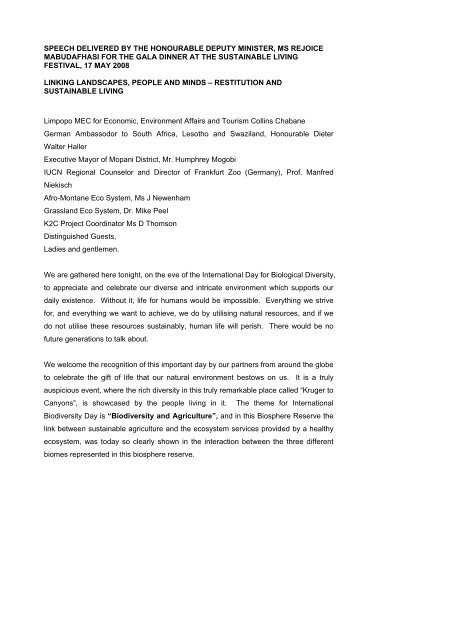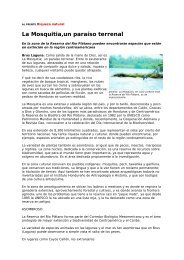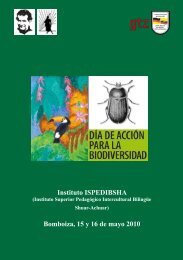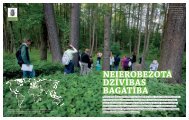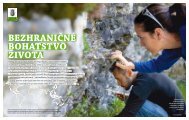speech delivered by the honourable deputy minister, ms rejoice ...
speech delivered by the honourable deputy minister, ms rejoice ...
speech delivered by the honourable deputy minister, ms rejoice ...
Create successful ePaper yourself
Turn your PDF publications into a flip-book with our unique Google optimized e-Paper software.
SPEECH DELIVERED BY THE HONOURABLE DEPUTY MINISTER, MS REJOICE<br />
MABUDAFHASI FOR THE GALA DINNER AT THE SUSTAINABLE LIVING<br />
FESTIVAL, 17 MAY 2008<br />
LINKING LANDSCAPES, PEOPLE AND MINDS – RESTITUTION AND<br />
SUSTAINABLE LIVING<br />
Limpopo MEC for Economic, Environment Affairs and Tourism Collins Chabane<br />
German Ambassodor to South Africa, Lesotho and Swaziland, Honourable Dieter<br />
Walter Haller<br />
Executive Mayor of Mopani District, Mr. Humphrey Mogobi<br />
IUCN Regional Counselor and Director of Frankfurt Zoo (Germany), Prof. Manfred<br />
Niekisch<br />
Afro-Montane Eco System, Ms J Newenham<br />
Grassland Eco System, Dr. Mike Peel<br />
K2C Project Coordinator Ms D Tho<strong>ms</strong>on<br />
Distinguished Guests,<br />
Ladies and gentlemen.<br />
We are ga<strong>the</strong>red here tonight, on <strong>the</strong> eve of <strong>the</strong> International Day for Biological Diversity,<br />
to appreciate and celebrate our diverse and intricate environment which supports our<br />
daily existence. Without it, life for humans would be impossible. Everything we strive<br />
for, and everything we want to achieve, we do <strong>by</strong> utilising natural resources, and if we<br />
do not utilise <strong>the</strong>se resources sustainably, human life will perish. There would be no<br />
future generations to talk about.<br />
We welcome <strong>the</strong> recognition of this important day <strong>by</strong> our partners from around <strong>the</strong> globe<br />
to celebrate <strong>the</strong> gift of life that our natural environment bestows on us. It is a truly<br />
auspicious event, where <strong>the</strong> rich diversity in this truly remarkable place called “Kruger to<br />
Canyons”, is showcased <strong>by</strong> <strong>the</strong> people living in it. The <strong>the</strong>me for International<br />
Biodiversity Day is “Biodiversity and Agriculture”, and in this Biosphere Reserve <strong>the</strong><br />
link between sustainable agriculture and <strong>the</strong> ecosystem services provided <strong>by</strong> a healthy<br />
ecosystem, was today so clearly shown in <strong>the</strong> interaction between <strong>the</strong> three different<br />
biomes represented in this biosphere reserve.
The hundreds of participants in today’s biodiversity monitoring programme have<br />
experienced first-hand how biodiversity within <strong>the</strong> framework of a healthy ecosystem<br />
contributes to <strong>the</strong> provision of clean water, pest control, pollination, soil fertility, disaster<br />
management, and with all of <strong>the</strong>se, to sustainable production of food. Without all of<br />
<strong>the</strong>se services, sustainable agriculture will not be possible, and eradication of poverty<br />
will be a pipe dream.<br />
Biospheres:<br />
Biosphere Reserves are designated regions throughout <strong>the</strong> world where internationally<br />
important protected areas lie adjacent to human settlements which need to use <strong>the</strong> land<br />
for a multiplicity of purposes. This creates a link between <strong>the</strong> protection of biodiversity<br />
and <strong>the</strong> provision of ecosystem services with <strong>the</strong> management of environments outside<br />
of protected areas. It is this link between ecosystem services, capacity building and<br />
sustainable livelihoods that <strong>the</strong> Kruger to Canyons Biosphere is so well able to<br />
demonstrate, with its ecosyste<strong>ms</strong> ranging from grasslands containing mountain<br />
catchments, through forests that filter and purify <strong>the</strong> water, to savannahs providing<br />
grazing for both cattle and <strong>the</strong> rich diversity of African game that makes South Africa a<br />
prime tourism destination.<br />
Internationally Biosphere Reserves are recognised as areas that include all types of<br />
land use – from conservation to agriculture and human habitation. It not only links landuse<br />
patterns, but provides an arena for <strong>the</strong> fur<strong>the</strong>ring of scientific knowledge, technical<br />
competence and human values through capacity building for sustainable resource<br />
management and use <strong>by</strong> communities <strong>the</strong><strong>ms</strong>elves. It is areas where national, provincial<br />
and local action plans for sustainable development can be formulated through<br />
participative community involvement, and <strong>the</strong> sharing of benefits arising from <strong>the</strong><br />
sustainable utilisation of resources.<br />
Each Biosphere reserve is conceived to fulfil a developmental, conservation as well as<br />
logistical role. The developmental role combines conservation objectives with <strong>the</strong><br />
sustainable use of natural resources <strong>by</strong> local communities for <strong>the</strong>ir benefit, while <strong>the</strong><br />
conservation role protects natural resources, ecosyste<strong>ms</strong> and landscapes of value to<br />
maintain biodiversity and life-support syste<strong>ms</strong>.
The logistical role provides research, monitoring, education and training opportunities<br />
for <strong>the</strong> communities within <strong>the</strong> biosphere. This will lead to sustainable resource<br />
management through co-operation with local communities.<br />
South Africa realised <strong>the</strong> advantage of biospheres, especially as a vehicle to achieve<br />
biodiversity conservation and community development as both are vital for poverty<br />
alleviation. DEAT has <strong>the</strong>refore placed <strong>the</strong> development of biospheres as one of <strong>the</strong><br />
priority projects within <strong>the</strong> National Biodiversity Framework, and will work towards<br />
supporting <strong>the</strong> establishment of <strong>the</strong>se reserves right across <strong>the</strong> country. This will<br />
streng<strong>the</strong>n <strong>the</strong> implementation of <strong>the</strong> goals of biosphere reserves in ter<strong>ms</strong> of equity,<br />
benefit-sharing and capacity building, while addressing both conservation of resources<br />
and development of communities equally. In this way <strong>the</strong> conservation of biodiversity<br />
will be reconciled with <strong>the</strong> quest for economic and social development and <strong>the</strong><br />
maintenance of cultural values. To date 5 biosphere reserves have been listed on <strong>the</strong><br />
world network of biosphere reserves <strong>by</strong> UNESCO with <strong>the</strong> newest addition listed in<br />
September 2007. A number of o<strong>the</strong>r initiatives are currently being developed that will<br />
lead to <strong>the</strong> expansion of <strong>the</strong> biosphere network in South Africa.<br />
K2C contributing to national goals<br />
The strength of <strong>the</strong>se processes are that <strong>the</strong>y benefit people <strong>by</strong> providing communities<br />
with <strong>the</strong> framework of opportunities to become stakeholders in <strong>the</strong>ir land and resources<br />
and at <strong>the</strong> same time give security to landowners and create opportunities to fur<strong>the</strong>r<br />
develop <strong>the</strong>ir capacity to respond to community needs. The “Sustainable Living<br />
Festival” is but one of <strong>the</strong> ways in which <strong>the</strong> K2C strives to address capacity building in<br />
communities.<br />
This Festival is organised to implement <strong>the</strong> main ideas around <strong>the</strong> establishment of<br />
Biospheres. It has targeted <strong>the</strong> ecological, social and economic dimensions of<br />
biodiversity loss, through an exercise in knowledge-sharing, research and monitoring<br />
that will lead to capacity building and participatory decision-making. The whole<br />
community, including learners, community members, farm labourers, politicians and<br />
private landowners have worked toge<strong>the</strong>r to showcase <strong>the</strong> richness of <strong>the</strong>ir environment,<br />
and <strong>the</strong> ecosystem services that it can provide to <strong>the</strong> people of this land.
At <strong>the</strong> same time <strong>the</strong>y have established a benchmark against which <strong>the</strong> environment<br />
can be evaluated, creating a rich learning environment for all who want to participate in<br />
future.<br />
Ecosystem services are a vital part of poverty alleviation, as this provides communities<br />
with <strong>the</strong> basic resources needed for sustainable livelihoods. These services include <strong>the</strong><br />
storage of water for dry seasons in mountain catchment areas, <strong>the</strong> purification of water<br />
through wetlands, <strong>the</strong> mitigation of wea<strong>the</strong>r extremes like floods and droughts through<br />
both catchments and wetlands, pollination of food crops and natural vegetation used for<br />
grazing, nutrient cycling and <strong>the</strong> improvement of soil fertility, prevention of erosion,<br />
climate stability and maintenance of biodiversity. All of <strong>the</strong>se services, or <strong>the</strong> lack<br />
<strong>the</strong>reof, have a direct impact on <strong>the</strong> poverty levels of especially rural people. The<br />
biosphere, in maintaining <strong>the</strong>se services, and building <strong>the</strong> capacity of communities to<br />
manage <strong>the</strong> ecosyste<strong>ms</strong> on which <strong>the</strong>se services are dependent,<br />
Communities have to manage <strong>the</strong>ir own environments, and for this to be successful,<br />
<strong>the</strong>y have to be <strong>the</strong> landowners. Because of this, land restitution is one of <strong>the</strong> important<br />
issues that are being addressed in <strong>the</strong> biosphere. All DEAT-funded development in <strong>the</strong><br />
National Park involves <strong>the</strong> communities in decision-making processes, and communities<br />
involved in land clai<strong>ms</strong> in Mpumalanga are working with <strong>the</strong> Mpumalanga Tourism and<br />
Parks Agency to establish agreements with respect to beneficiation and settlement<br />
agreements. The communities have already reached agreement on <strong>the</strong> 12 principles,<br />
and fur<strong>the</strong>r workshops need to conduct to reach agreements on outstanding issues.<br />
The communities are very supportive of <strong>the</strong> continuation of protected areas and <strong>the</strong><br />
associated eco-tourism.<br />
This will enable <strong>the</strong> communities to empower <strong>the</strong><strong>ms</strong>elves to access resources and<br />
develop <strong>the</strong> capacity to take part in <strong>the</strong> economic activities of <strong>the</strong> region on an equal<br />
footing. The capacity building programmes that form part of <strong>the</strong> Biosphere reserve will<br />
ensure skills transfer, equity and benefit–sharing for everybody.
The Future:<br />
DEAT is committed to <strong>the</strong> implementation and support of <strong>the</strong> Man and <strong>the</strong> Biosphere<br />
programme. This “Sustainable Living Festival” is a vehicle that can be used to ensure<br />
continuity in capacity building programmes, and we will strive to support <strong>the</strong> K2C as one<br />
of <strong>the</strong> implementing partners in this programme wherever possible. Greater efforts<br />
should be made to bring onboard active participation of women in <strong>the</strong> vicinity and<br />
educating <strong>the</strong> adjacent communities about sustainable use of and <strong>the</strong> importance of<br />
protecting <strong>the</strong> environment.<br />
Thank you,<br />
Deleted: UNESCO's Man and <strong>the</strong><br />
Biosphere Programme (MAB)<br />
The Man and <strong>the</strong> Biosphere Programme<br />
(MAB), proposes an interdisciplinary<br />
research agenda and capacity building<br />
aiming to improve <strong>the</strong> relationship of<br />
people with <strong>the</strong>ir environment globally<br />
Background<br />
<br />
Approach (Extract from UNESCO's Draft<br />
Programme 2006-2007)<br />
"The General Conference authorizes <strong>the</strong><br />
Director-General […] to implement <strong>the</strong><br />
corresponding plan of action in <strong>the</strong><br />
ecological sciences […], in order to:<br />
(i) Contribute to minimizing biodiversity<br />
loss through <strong>the</strong> use of ecological and<br />
biodiversity sciences in policy- and<br />
decision-making; <br />
(ii) Promote environmental sustainability<br />
through <strong>the</strong> World Network of Biosphere<br />
Reserves; <br />
(iii) Enhance <strong>the</strong> linkages between<br />
cultural and biological diversity, jointly<br />
with [Major Programme IV- Culture]" <br />
Main line of action 1: Minimizing<br />
biodiversity loss through research and<br />
capacity-building for ecosystem<br />
management<br />
Focus will be on a broad-based<br />
interdisciplinary research agenda with<br />
respect to <strong>the</strong> ecological, social and<br />
economic dimensions of biodiversity loss<br />
and its reduction. Capacity-building will<br />
be key […], including <strong>the</strong> development of<br />
a network of learning centres for<br />
integrated ecosystem management and<br />
through South-South cooperation. In<br />
Africa, <strong>the</strong> regional postgraduate school<br />
in Kinshasa, Congo DR, will serve as <strong>the</strong><br />
principal node for this network.<br />
Efforts will be made to promote<br />
interdisciplinary and multisectoral<br />
approaches to sustainable development in<br />
higher education and in-service training<br />
institutions, particularly in post-conflict<br />
countries.<br />
State-of-<strong>the</strong>-art syn<strong>the</strong>sis will be<br />
undertaken and new research initiatives<br />
on arid lands and humid tropics will be<br />
launched, capping 50 years (2006) of<br />
UNESCO's involvement in <strong>the</strong>se areas. <br />
Research, training and education related<br />
to biodiversity loss and global<br />
assessments <br />
Urban syste<strong>ms</strong>, carbon economies and<br />
ecosystem management for biodiversity<br />
use <br />
Research, training and ecosystem<br />
management of drylands and mountains <br />
Research and ecosystem management in<br />
coastal areas and humid tropics and<br />
South-South cooperation for capacitybuilding<br />
<br />
Main line of action 2: Biosphere reserves<br />
- promoting environmental sustainability<br />
Emphasis will be placed on linkages<br />
between biodiversity conservation and<br />
socio-economic development in specific<br />
biosphere reserve contexts. The WNBR<br />
and its regional networks will be used as<br />
vehicles for knowledge-sharing and<br />
exchange of experience, research and<br />
monitoring, education and training, and<br />
testing of participatory decision-making, ... [1]<br />
Formatted: Bullets and Numbering
Page 5: [1] Deleted DEATER 5/14/2008 11:13:00 AM<br />
UNESCO's Man and <strong>the</strong> Biosphere Programme (MAB)<br />
The Man and <strong>the</strong> Biosphere Programme (MAB), proposes an interdisciplinary research agenda and capacity building aiming to<br />
improve <strong>the</strong> relationship of people with <strong>the</strong>ir environment globally<br />
Background<br />
Approach (Extract from UNESCO's Draft Programme 2006-2007)<br />
"The General Conference authorizes <strong>the</strong> Director-General […] to implement <strong>the</strong> corresponding plan of action in <strong>the</strong> ecological<br />
sciences […], in order to:<br />
(i) Contribute to minimizing biodiversity loss through <strong>the</strong> use of ecological and biodiversity sciences in policy- and decision-making;<br />
(ii) Promote environmental sustainability through <strong>the</strong> World Network of Biosphere Reserves;<br />
(iii) Enhance <strong>the</strong> linkages between cultural and biological diversity, jointly with [Major Programme IV- Culture]"<br />
Main line of action 1: Minimizing biodiversity loss through research and capacity-building for ecosystem management<br />
Focus will be on a broad-based interdisciplinary research agenda with respect to <strong>the</strong> ecological, social and economic dimensions of<br />
biodiversity loss and its reduction. Capacity-building will be key […], including <strong>the</strong> development of a network of learning centres for<br />
integrated ecosystem management and through South-South cooperation. In Africa, <strong>the</strong> regional postgraduate school in Kinshasa,<br />
Congo DR, will serve as <strong>the</strong> principal node for this network.<br />
Efforts will be made to promote interdisciplinary and multisectoral approaches to sustainable development in higher education and inservice<br />
training institutions, particularly in post-conflict countries.<br />
State-of-<strong>the</strong>-art syn<strong>the</strong>sis will be undertaken and new research initiatives on arid lands and humid tropics will be launched, capping 50<br />
years (2006) of UNESCO's involvement in <strong>the</strong>se areas.<br />
Research, training and education related to biodiversity loss and global assessments<br />
Urban syste<strong>ms</strong>, carbon economies and ecosystem management for biodiversity use<br />
Research, training and ecosystem management of drylands and mountains<br />
Research and ecosystem management in coastal areas and humid tropics and South-South cooperation for capacity-building<br />
Main line of action 2: Biosphere reserves - promoting environmental sustainability<br />
Emphasis will be placed on linkages between biodiversity conservation and socio-economic development in specific biosphere reserve<br />
contexts. The WNBR and its regional networks will be used as vehicles for knowledge-sharing and exchange of experience, research<br />
and monitoring, education and training, and testing of participatory decision-making, <strong>the</strong>re<strong>by</strong> contributing to <strong>the</strong> emergence of<br />
"quality economies" and to conflict prevention.<br />
Establishing new biosphere reserves and transboundary biosphere reserves<br />
Streng<strong>the</strong>ning of knowledge base on environmental sustainability - including <strong>the</strong> Great Apes Survival Project (GRASP), and <strong>the</strong><br />
Biosphere Reserve Integrated Monitoring (BRIM) programme<br />
Using biosphere reserves as platform for conflict prevention<br />
Statutory meetings and MAB Young Scientists Award Scheme<br />
Supporting regional and <strong>the</strong>matic MAB networks<br />
Main line of action 3: Enhancing linkages between cultural and biological diversity<br />
Cultural landscapes and sacred sites will receive special attention and allow to learn about biological and cultural diversity<br />
interactions. Special attention will be given to biosphere reserves and World Heritage sites.
Establishing a knowledge base on cultural practices fostering local-level sustainable use of biodiversity in biosphere reserves<br />
Local and indigenous knowledge as a basis for equitable biodiversity governance in Small Island Developing States<br />
Raising awareness of <strong>the</strong> role of sacred natural sites, cultural landscapes and intangible heritage in ecosystem management and<br />
sustainable use of biodiversity


